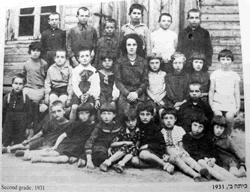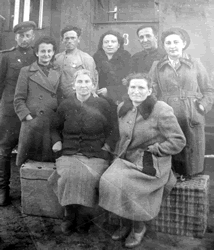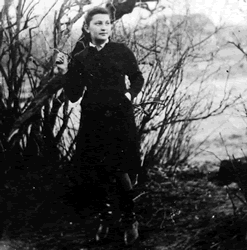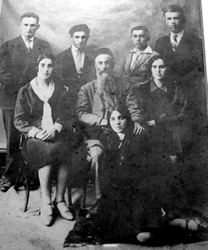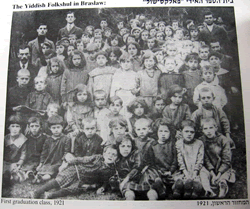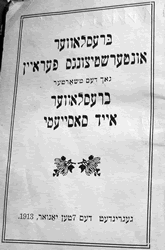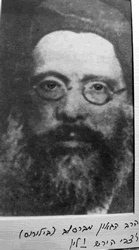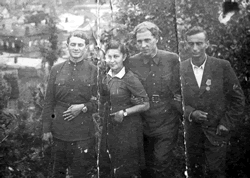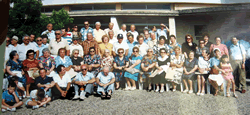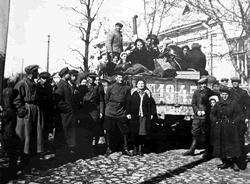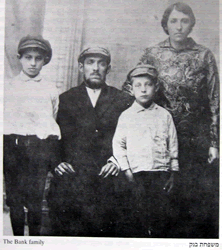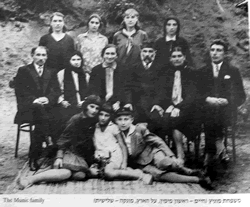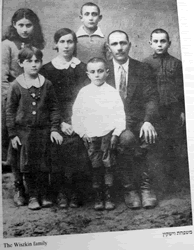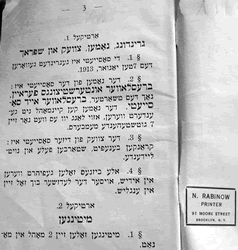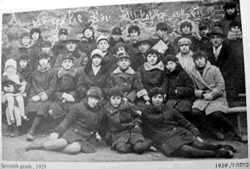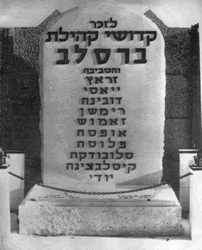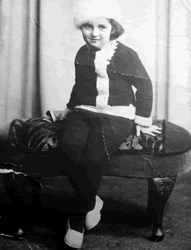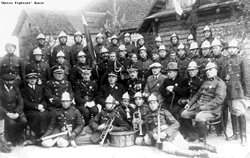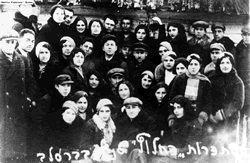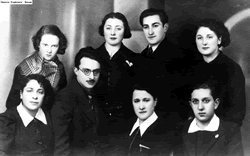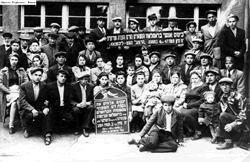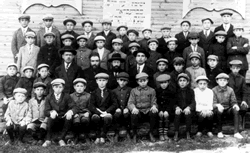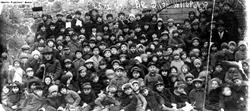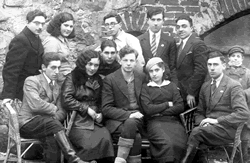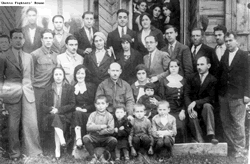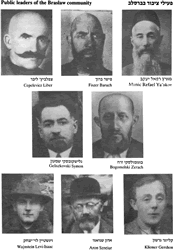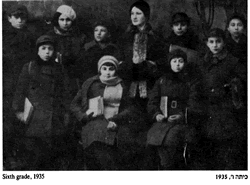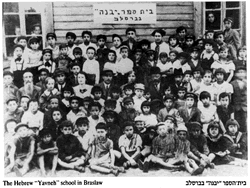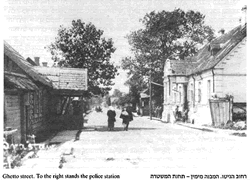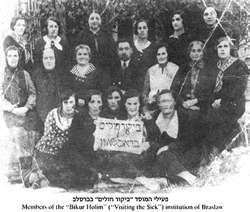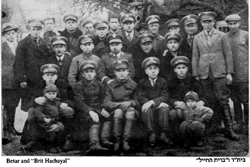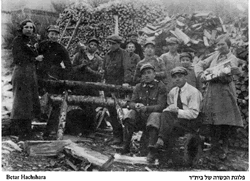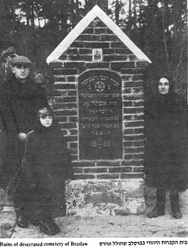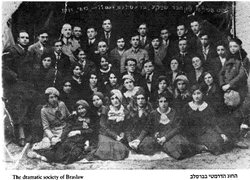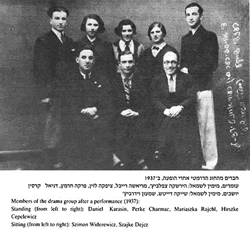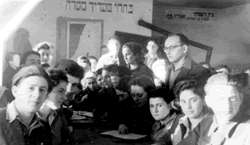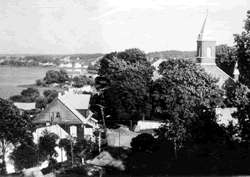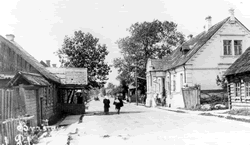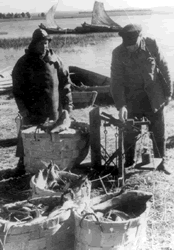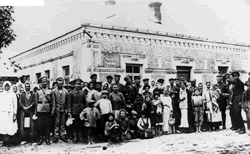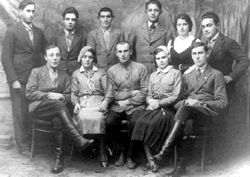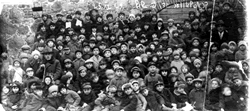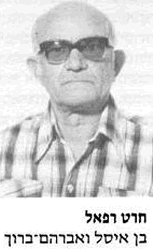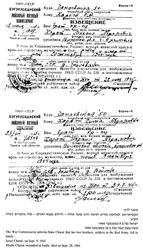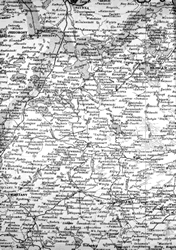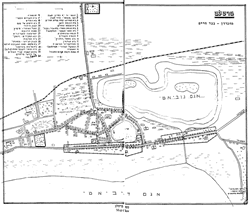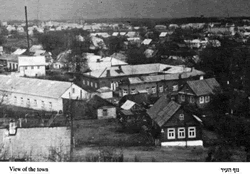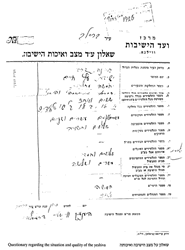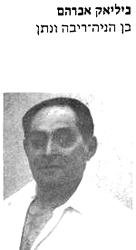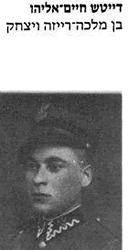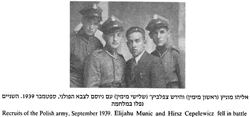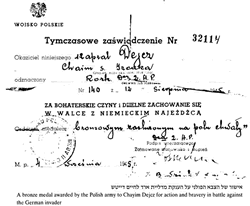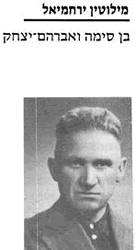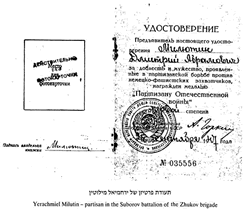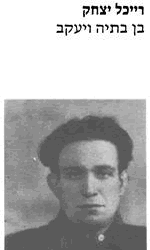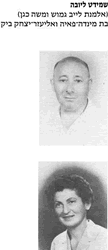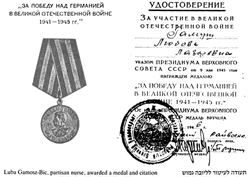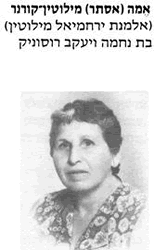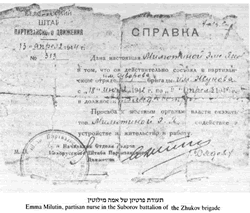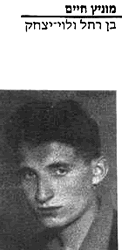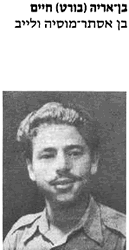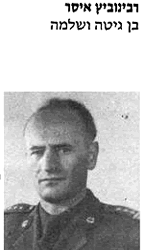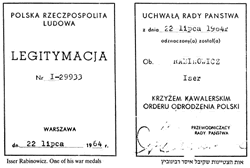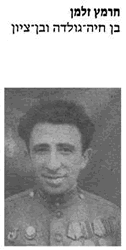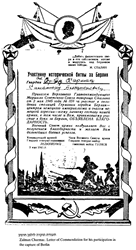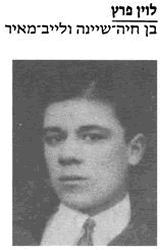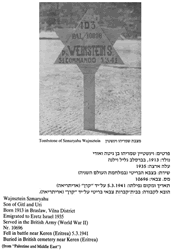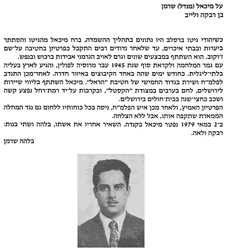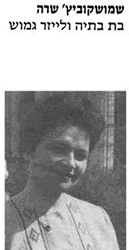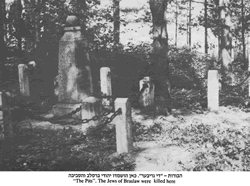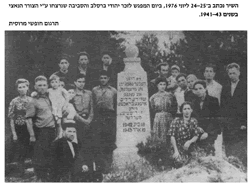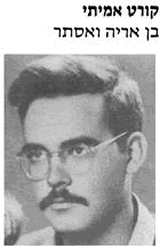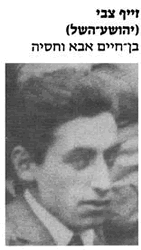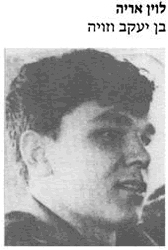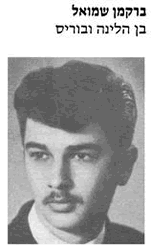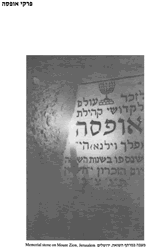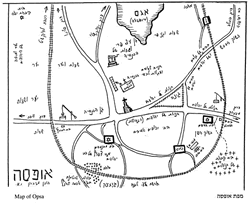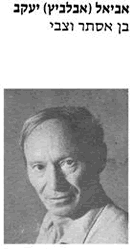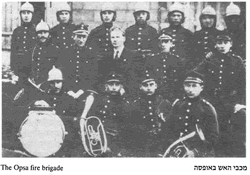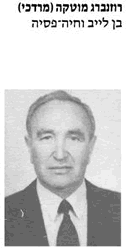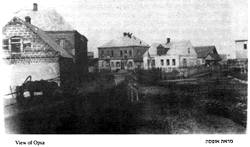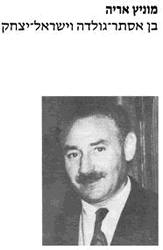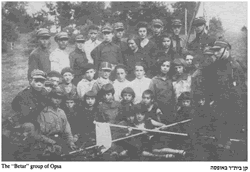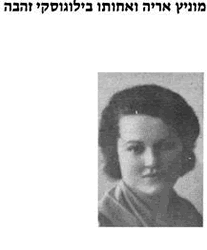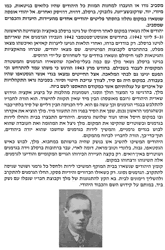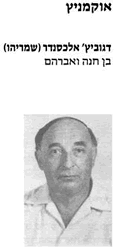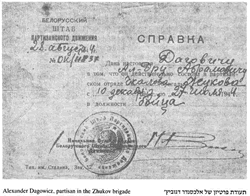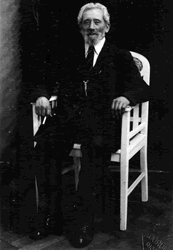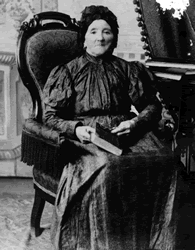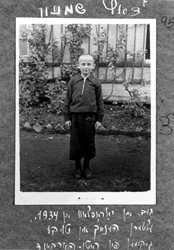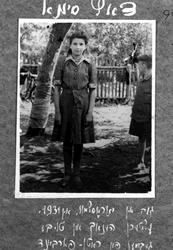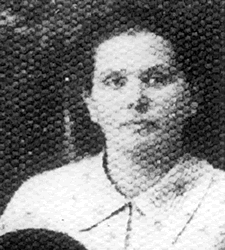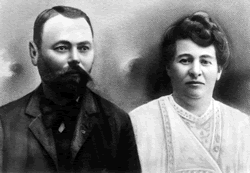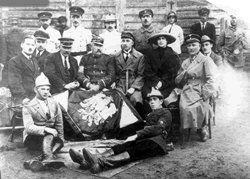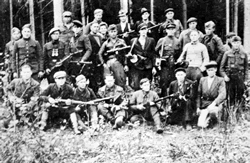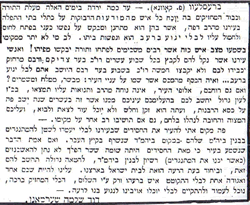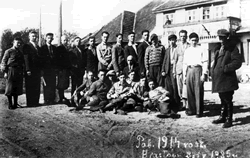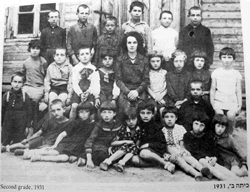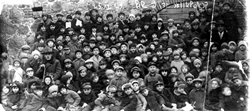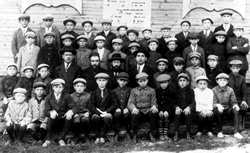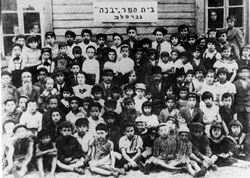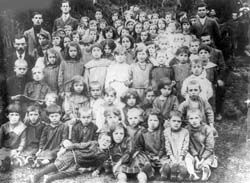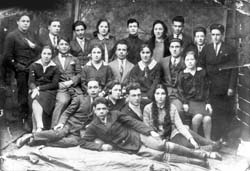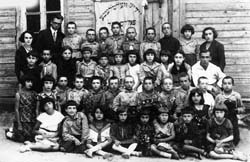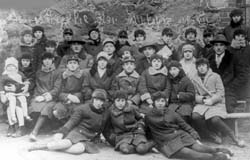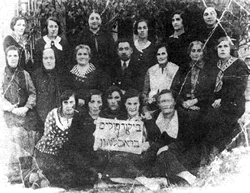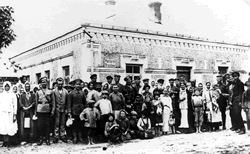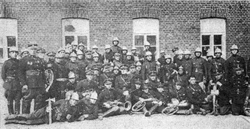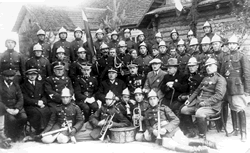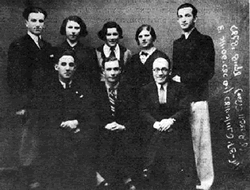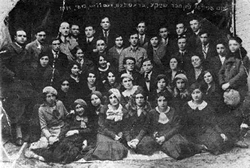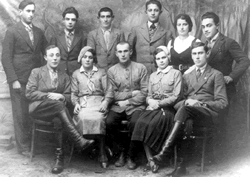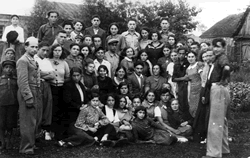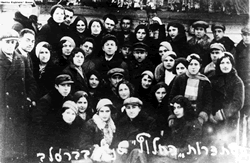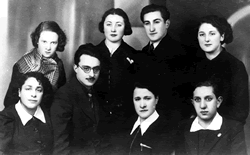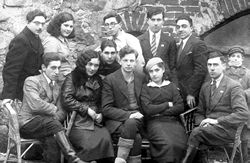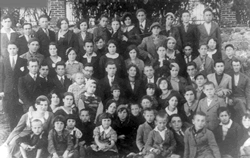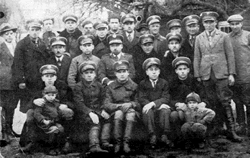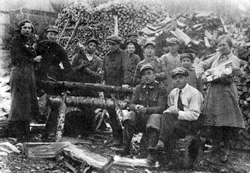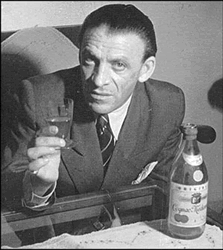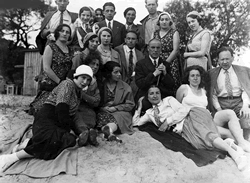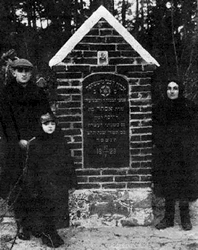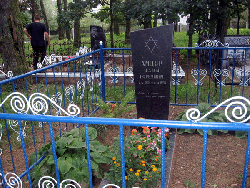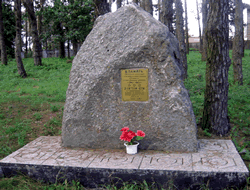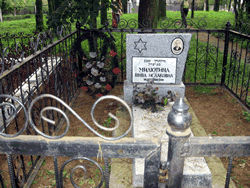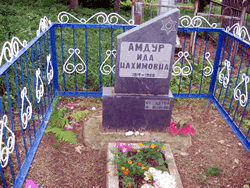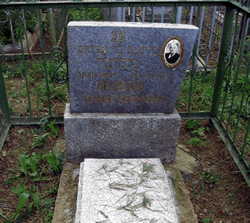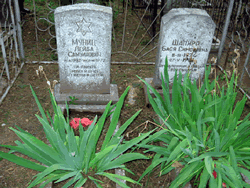Also known as Braslaw, Braslau and Breslauja
|
#bras-1:
|
#bras-2:
|
#bras-3:
|
|
#bras-4:
|
#bras-5:
|
#bras-6:
|
|
#bras-7:
|
#bras-8: On the right-Meer Beliak, my grandfather |
#bras-9:
|
|
#bras-10:
|
#bras-11:
|
#bras-12:
|
|
#bras-13:
|
#bras-14:
|
#bras-15:
|
#bras-16: |
#bras-17: |
#bras-18: |
#bras-19: |
#bras-20: |
#bras-21: |
#bras-22: |
#bras-23: |
#bras-24: |
#bras-25: |
#bras-26: Public leaders of the Braslav community |
#bras-27: |
#bras-28: |
#bras-29: The Ghetto street during the war. To the right stands the police station. |
#bras-30: Members of the Bikur Holim ("Visiting the Sick") institution of Braslaw |
#bras-31: |
#bras-32: |
#bras-33:Ruins of desecrated cemetary of Braslaw |
#bras-34: The dramatic society of Braslaw |
#bras-35: Members of the drama group after a performance (1937): |
#bras-36: |
#bras-37: |
#bras-38: |
#bras-39: |
#bras-40: |
#bras-41: |
#bras-42: |
#bras-43: Folke Rafael Charat, son of Eisel and Avraham Baruch Charad. AVRUM |
#bras-44: Israel |
#bras-45: |
#bras-46: |
#bras-47: View of the Town |
#bras-48: Questionary regarding the situation |
#bras-49: |
#bras-50: Soldier |
#bras-51: Recruits of the Polish Army |
#bras-52: Bronze medal award to Chayim Dejcz |
#bras-53: |
#bras-54: Yerachmiel Milutin Partisan Papers |
#bras-55: |
#bras-56: |
#bras-57: Luba Gamosz Bic Patisan Nurse Medal |
#bras-58: |
#bras-59: Emma Milutin Partisan Nurse Paper |
#bras-60: |
#bras-61: |
#bras-62: |
#bras-63: Isser Rabinowicz War Medal |
#bras-64: |
#bras-65: Zalman Charmac Letter of Commendation |
#bras-66: |
#bras-67: |
#bras-68: Tombstone of Szymaryahu Wajnstein |
#bras-69: |
#bras-70: |
#bras-71: The Pits |
#bras-72: Tombstone |
#bras-73: |
#bras-74: |
#bras-75: |
#bras-76: |
#bras-77: Memorial Stone on Mt Zion |
#bras-78: Map of Opsa |
#bras-79: |
#bras-80: Opsa Fire Brigade |
#bras-81: |
#bras-82: View of Opsa |
#bras-83: |
#bras-84: Betar Group of Opsa |
#bras-85: |
#bras-86: |
#bras-87: |
#bras-88: Alexander Dagowicz Partisan Paper |
#bras-89: Yehuda Leib Deutch (son of Sarah) of Braslav |
#bras-90: Sarah Deutch of Braslav |
#bras-91: A photograph of David Datz who was born in Braslav in 1938 OR Shimon Datz, 1947. |
#bras-92: A photograph of Sima Datz, 1947 |
#bras-93: Sonia Zeidlin nee Eidelson was born in Braslaw, Poland. She was a housewife. Prior to WWII she lived in Druja, Poland. Sonia was murdered/perished in 1942 in Druja, Poland at the age of 45. This |
#bras-94: Chaia Aharony with husband Hillel Aharony ( 1895- 1919). Chaia was born in Braslav to Shalom Zisel. She came with her husband and child to Rehovot in 1892. |
#bras-95: |
#bras-96: |
|
|
|
http://www.jewishgen.org/yizkor/Braslaw/Braslaw.html
http://www.jewishfamilyhistory.org/Map%20of%20Braslav%20District.htm
Please share your comments or photos or links for posting on our Guestbook Page here: egl.comments@gmail.com
kehiles Braslaw...
English Title: Darkness and desolation; in memory of the communities
of Braslaw, Dubene, Jaisi, Jod, Kislowszczizna, Okmienic, Opsa, Plusy,
Rimszan, Slobodka, Zamosz, Zaracz
Editor: Machnes Ariel, Klinov Rina
Published: Israel 1986
Publisher: Association of Braslaw and Surroundings in Israel and
America; Ghetto Fighters House and Hakibbutz Hameuchad Publishing
House
Pages: 636 Languages: H,Y,E
Notes: 65 pages are in English
Libraries
Bar-Ilan University, Ramat-Gan, , Israel, Call No: D47(438)
Price Library of Judaica, University of Florida, Gainesville, FL,
United States, Call No: Has book
New York Public Library, Jewish Division, New York, NY, United States,
Call No: *PXW(Braslav) 89-8626
YIVO Institute for Jewish Research Library, New York, NY, United
States, Call No: nc
Simon Wiesenthal Center/Yeshiva University Library, Los Angeles, CA,
United States, Call No: 87-709
Braslaw Yizkor book, table of content
Original Title: Emesh shoa; yad le-kehilot/gevidmet di
kehiles Braslaw...
English Title: Darkness and desolation; in memory of the communities
of Braslaw, Dubene, Jajsi, Jod, Kislowszczyzna, Okmienic, Opsa, Plusy,
Rimszan, Slobodka, Zamosz, Zaracz
Editor: Machnes Ariel, Klinov Rina
Published: Israel 1986
Publisher: Association of Braslaw and Surroundings in Israel and
America; Ghetto Fighters House and Hakibbutz Hameuchad Publishing
House
Pages: 636 Languages: H,Y,E
65 pages are in English
Table of Content
Notes from the editors 10
Braslaw- Chapters from her story
Braslaw, historical notes - Ya’acov Levin 15
For the memory of Yerachmiel Mendel Meirson - Miryam Rothenberg ( Marishka, daughter of Gitel and Velvel Rajchel) 35
As told by Perke Fisher (Perl Mina, daughter of Ben Zion and Chaia Golda Charmac) 37
As told by Yehuda Cepelewicz, son of Zvia and Leiba 43
As told by Ziska ( Reuven) Szmuszkowic, son of Gitl and Leib 59
The Community of Braslaw during the Shoah
Poem; Deep Deep Pits, and Red Red Loam - Shmuel Halkin 65
For the memory of my father, Rabbi Zvi Hirsh ( Reb Hirszl Valin) Z'L -Yisrael Valin
For the memory of the Rabbi Avraham Abba Ya’acov Zahorie Z''L - Tuvia Fiszer 68
About Chayim Munitz ( Munic) Z"L, born in 1911 to Shaitel and Rafael Yaacov - Ran Leiser 70
Masha ( Masza, daughter of Brine Malka and Chayim) and Mendel Maron ( son of Sofia and Chayim Isaac) tell their story 72
The story of Chayim Band, son of Chaia Chana and Avraham Leib 80
A common story; imprisonment, exile and fight - Ya’acov Lewin, son of Chaia Sheine and Leib Meir 86
The story of Motel Hirsh Fiszer, son of Beile Zelda and Baruch 90
The story of Yerachmiel Bielak, son of Sara Gitel and Chayim Leib 96
The story of Tuvia Fiszer, son of Beile Zelda and Baruch 108
The story of Henka Fiszer, son of 111
The story of Yeta Wishkin, daughter of Fania and Rafael Fiszer 117
Like arrows at the hands of the hero so were the youth- Poems and Notes written during the Shoah 120
The story of Anna ( Neyuta) Zelikman, daughter of Rachel and Ya’acov Kantor 124
From the Hall of the courthouse; the indictment of Stanislav Jasinski 134
The infamous Stanislav Jasinski; The murderer of the Braslaw Jews 136
How I survived.-.Boris Ulman, son of Leah and Zelig 143
The story of Moshe Wishkin, son of Sarah Leah and Tuvia 145
A survivor story- Eliezer Fiszer, son of Chaia and Feibush 155
The story of Young girl who survived-Zipora Toker (nee Feige Tsippe, daughter of Gisia and Chonzka Bielak) 159
The story of Sarah Mowszenson, widow of Yehuda Moshe and daughter of Riva and Mendel Katz 164
The story of Chana ( daughter of Sheitel and Rafael Yaacov Munic) and Zusman Lubowicz ( son of Chaia Leah and Avraham) 217
The story of Moshe ( Mosze, son of Sonia and Ber Leib) Milutin 227
The story of Rafael Charat, son of Eisel and Avraham Baruch 234
The story of Avraham Bielak, born in 1924 to Henia Riva and Natan 239
The story of Chayim Eliahu Dejcz (son of Malka Reiza and Yitzchak Daitch) 245
The story of Yerachmiel Milutin, son of Sima and Avraham Yitzchak 254
The story of Yitzchak Rajchel , son of Batia and Ya’acov 258
The story of Lyuba Smidt, born in 1919 to Minda Peya and Eliezer Yitzchak Bik. Widow of Leib Gamusz and Moshe Kagan 263
The story of Ester Emma Milutin- Korner, daughter of Nechama and Yaacov Rosonik, widow of Yerachmiel Milutin 274
A 1946 letter from the Soviet Union by Chayim Munic ( son of Rachel and Levi Yitzchak) to his sister; Monka Shmutzer in Kibbutz Ein Yam 280
About Tevale (Tuvia) Bielak, son of Henia Riva and Natan- notes from his friends in the Partisans unit 283
About Moshe Baruch Bank and his two sons- Y. Lewin 286
From the Ghetto to the partisans and a soldier of the I.D.F. - Chayim Ben Arieh ( nee Bort) 288
About Issar Rabinowicz, born in 1914 to Gita and Shlomo 293
The story of Zalman Charmatz, son of Chaia Golda and Ben Zion 297
Letters from Peretz Levin (son of Chaia Sheina and Leib Meir) who fell as a Red Army soldier on 2-8- 1945 300
The three brothers Wajnsztein join the combat; Ther story of Shmaryahu Z”L, Shmuel Z”L and Israel Yosef, sons of Gitl and Uri 302
About Gershon) Jankelewicz, born in Braslaw in 1910, killed in combat; 9-9-1943- Y. Levin 308
About Michael ( Mendel) Sherman Z”L, A Shoah survivor who passed away in 1979 309
Braslaw after the war- Sarah Szmuszkowicz, daughter of Batia and Leizer Gamusz 310
On the terrain of Braslaw (Commemoration poem) - Yoel Nimnov 312
As a memorial to the fallen
A father; On the passing of my son I lament ( poem) 313
Amity Kort, born in 1936 to Ester and Arieh, fell in 1956 defending Israel 315
Chaim Robowitz, born in 1929 to Moshe and Shoshana fell in 1948 defending Israel 316
Zvi ( Yehoshua Heshel) Zeif born in Braslaw in 1912 to Chayim Abba and Chasia fell in 1948 defending Israel 316
Arieh Levin, born in 1946 to Yaakov and Zoya Chasia fell in 1968 defending Israel 317
Shmuel Berkman born in 1948 to Halina and Boris fell in 1973 defending Israel 318
The shtetl Opsa;
Reminiscence of Opsa- Ya’acov Aviel, nee Abelewitz, son of Ester and Zvi 323
The survival story of Motke ( Mordechai) Rosenberg, born in 1928 to Leib and Chaia Pesia 339
Opsa, the shtetl and her Jews - Arieh Munitz 352
Melehke the "Groy"( Hero), the story of Melech Munitz, son of Israel Yitzhak and Ester Golda- Arieh Munitz and his sister; Zahava Bilogoski 354
The shtetl Okmienic
The survival story of Alexander ( Shmaryahu) Dagowicz, born in 1923 to the sole Jewish family in Okmienic 354
The shtetl Dubene
The survival story of Sima Morzki, born in 1926 to Ester ( also survived) and Israel Yizhak Feigin 367
The survival story of Rivka Rokszin, daughter of Chaia and Meir Maron 377
The story of Mira Lotz, born in 1926 to Rachel Lea and David Shneider 381
After Dubene was liberated…Zalman Lewin, son of Sterl and Motl 389
The story of the sole survivor of a large family- Chana Fejge Berkman, born in 1915 to Ester and Hirsh Skopiec 390
The shtetl Zamosz
The survival story of Chalvina Pincow, son of Zvia and Menachem Mendel 393
The shtetl Zaracz
The story of Shlomo Rajchel, son of Reizel ( nee Krasin) and Mendel. The sole survivor of the only Jewish family in Zarach 397
The Shtetl Jajsi
The survival story of Szne'er Munitz, son of Rivka and Avraham Ya’acov Munic 399
Chapters for the shtetl Jod (Jody)
The survival story of Slawa Pincow, daughter of Sara and Chaim Shalom Bor 405
The survival story of Zalman Fisher, son of Chaia Sara and Yitzhak 427
The survival story of Luba Janowsski , born in 1925 to Miryam ( nee Zilberman) and Moshe Wilkicki 433
Partisans in the area of Braslaw- maps and notes from the book; Partisans in the Vileika region by Kilmov and Grakov 440
Partisans natives of Jod ( Pinchas Jofe, Binyamin Dobyonski, Avraham Wilkicki, Shimon Zilberman, Shalom Munitz, Piwel taruk, 441
The shtetl Slobodka
The survival story of Boris Berkman, son of Mira Leah and Shmuel Hillel 445
The shtetl Kislowszczyzna
The survival story of Masha Kapitza, born in 1929 to Zvia and Ya’acov ( also survived) Rakszin 451
Yizkor
To our perished community - Polia ( Pesia) kahat, daughter of Frida and Sander Weif 459
Facing the memorial stone (poem) Ya’acov Aviel 463
Those we'll commemorate....( Lists of Perished)
Braslaw 467
Opsa 482
Dubene 484
Zamosz 486
Jajsi 487
Jod 488
Slobodka 492
Plusy 494
Rimszan 495
My perished town; abridged version of the Hebrew text in Yiddish 497 – 573)
Darkness and Desolation- abridged version of the Hebrew text in English 636 – 573- paged backward, Hebrew version.
http://www.seligman.org.il/slobodka_braslav_home.html
History of Braslav
http://www.seligman.org.il/braslav_history.html
Braslav during the holocaust;
http://seligman.org.il/braslav_holocaust.html
Jewish Partisans from the Braslav Area Forests
http://www.seligman.org.il/braslav_holocaust.html
http://www.yahadmap.org/#village/braslav-vitebsk-belarus.374
From; http://www.seligman.org.il/braslav_jews.html
The Jewish Community of Braslav
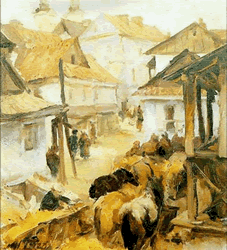
The first evidence of Jews in Braslav dates to the 16th century, a period characterised by the migration of Jews from Vilna to the small towns that surrounded it. A census of 1569 mentions the names of three Jewish families with a long history in the area - Byk, Krawitz and Nemirowitz. They were involved in typical Jewish professions of the Pale of Settlement - commerce and trades such as tailors, cobblers and innkeepers.
During the 17th century a report of the envoy-extraordinary of King Stanislaw-August Poniatowski of Poland rather strangely states that Braslav's Jews and its district enjoyed equal civil rights similar to those granted to the Jews of Britain and Holland. However, other documents give a contrary impression. The rights of Jews under the Russians and Poles was precariousness. They were mistrusted and viewed as spies and enemies of Christianity. In a situation where the border lines were fluid, Jews found themselves in an impossible position, pincered between the two powers, with the each new ruler challenging their loyalty. At times Jews could practice agriculture, at others not, community organisations were created and then broken. Still life continued and more Jews arrived in Braslav between the 16th to 18th century making their living from the trade of wood, flax, grain and the operation of inns in the surrounding area.
In an attempt to settle empty lands, the Czarist throne distributed land for the establishment of Jewish colonies in 1847. This settlement, which included the resettlement of Slobodka, would develop into the small shtetlach of Dubene, Jajsi, Drujsk, Plussy, Kislowszczyzna and Ukazne. Colonisation was encouraged by exemption from the draconian enlistment to the Czar's army and from the head tax. But government was fickle and by the mid-19th century the regime began to obstruct the same Jewish settlements, such that by 1864 it decided to proscribe the purchase of agricultural land by Jews and two years later Jews were even prevented from working the land. Still many Jews continued to be active farmers. Thus HaMelitz (a Hebrew language newspaper) of January 1885 referring to the shtetl of Drujsk, only 18 km from Braslav, criticises Jewish farmers for abandoning their agricultural lives to pursue trade and commerce.
During the nineteenth century Braslav was a town with 1234 of the 1500 residents belonging to the Jewish community. The Jews of the region were organised into independent communities in the larger towns of Braslav, Druya and Vidze, while the smaller shtetlach in Plussy, Slobodka and Drujsk were subordinated to the towns.
Articles from HaMelitz - 1884-5
The articles describe the conflict between the Chasidim and the Mitnagdim in Braslav that followed the burning of the Mitnaged Beth Midrash in 1884. The Chasidim objected to the rebuilding of the structure and complained to the Russian authorities. This led to the temporary closure of all the synagogues in Braslav by the government.During the nineteenth century Braslav was a town with 1234 of the 1500 residents belonging to the Jewish community. The Jews of the region were organised into independent communities in the larger towns of Braslav, Druya and Vidze, while the smaller shtetlach in Plussy, Slobodka and Drujsk were subordinated to the towns.
Articles from HaMelitz - 1884-5
The articles describe the conflict between the Chasidim and the Mitnagdim in Braslav that followed the burning of the Mitnaged Beth Midrash in 1884. The Chasidim objected to the rebuilding of the structure and complained to the Russian authorities. This led to the temporary closure of all the synagogues in Braslav by the government.
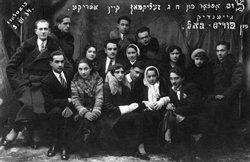
With the outbreak of war with Japan many of the Jewish youths were mobilized to the Czarist army during the Russo-Japan war, a fact that did not prevent Russian nationalists from blaming the Jews for the downfall. A result of this was a pogrom that took place in the town that caused many Jews to leave, the richer to establish businesses in Danzig and many others started to emigrate, especially to the US and South Africa. Their houses were soon taken by Jews from the surrounding shtetlach. A similar anti Semitic event took place after the retreat of the Germans in 1918, but his time the youth organised to form a self-defense group to prevent attacks on the community and the looting of its property.
Jewish Recruits to the Polish Army
Braslav 1935
Purim Ball for Getzel Seligman in Braslav Marking his Emigration to Africa - 1934
Synagogues and Religious Life
Braslav supported four synagogues. Three were located in the synagogue court, the Chasidic Old and New Minyanim and the Beth Midrash of theMitnagdim. A further synagogue, known as the Sandy Minyan, was located beside the Castle Hill. It too operated in the Chasidic tradition. The Mitnaged shul also functioned as a yeshiva for sixty students under the tutorage of Rabbi Chaim Tarshish from Jaisi under the title - 'Etz Chaim'. As part of a long tradition the students were fed in a communal kitchen supplemented by meals given one day a week in the homes of the community. But funds were limited and the Yeshiva was often short of them, as it relied exclusively upon donations. Still graduates of the Braslav Yeshiva managed to move on to higher Yeshivot at Volozyn, Mir, Vilna, andNowogrudek, some even receiving semicha as Rabbis.
The shtetl employed two Rabbis. In the interwar period these were Rav Zvi Hirsch Valin, the Mitnaged Rabbi, a well known preacher and cantor, and Rabbi Abba Zahorie, the religious leader of the Chassidic community. He would go to the death pits with the rest of Braslav's Jews. The Jewish community was acutely divided between the two groups. HaMalitz of 1894-5 described mutual denunciations to the secular authorities concerning unauthorised construction. This led to the official closure of the Mitnaged synagogue and the arrest of some of the congregants. This situation was exacerbated by a fire that destroyed the three synagogues a year later.
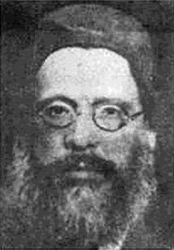
Synagogues, Schools, Benevolent Societies and Community Organisations
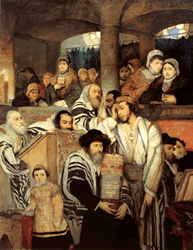
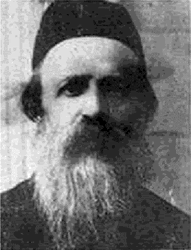
Yom KippurMaurycy Gottlieb1878
Rabbi Zvi Hirsch Valin
Rabbi Abba Zahorie
Schools and Education
Prior to the First World War, the children of Braslav were educated in traditional Cheders and in the Talmud Torah. The more affluent received additional private tutoring in Russian and general subjects. Some would even make their way to the gymnasia in the larger cities. Most however, on leaving school, would immediately enter the professions of their parents. Polish rule would bring some changes. Primary schooling was provided by the Polish government and by the community. However, in the villages around Braslav there were no Jewish schools. Children would attend the government school in the morning and the communities would give schooling in Jewish subjects at the Cheder and Talmud Torah in the afternoon. The more affluent sent their children to Braslav, to the Yiddish language Folkshul or to the Hebrew language school - Yavneh. The more religiously inclined would attend the Yeshiva.
The Folkshul, influenced by Bundist ideas, conducted its Yiddish language classes in the women's section of the synagogue. Quarrels erupted between the Folkshul and the Yeshiva due to the 'permissive' dress of the pupils of the Folkshul. During the thirties funds were raised by the Central Yiddish School Organization in Vilna and the Jewish Bank Director, Levi Yitschak Weinstein, to build a purpose built structure. The new school was erected in the grounds of the Jewish Bank and further resources were granted to sponsor continuing study in Vilna for the children from poor homes. The Folkshul became the focus of the local Jewish intelligentsia and its graduates would pass on into the government high schools and then on to institutions of higher learning, especially in Vilna. Returning to Braslav as teachers, professionals and technicians they enriched the cultural life and quality of the youth.
On the initiative of a number of townspeople and communal workers connected with the Mizrachi movement, a Hebrew language school 'Yavneh' was established prior to World War II. Among its renowned teachers was Rafael Yaakov Munitz, who in the twenties had organised the youth to study Hebrew, Bible, and encouraged the youth to prepare for Aliyah to Eretz Israel. Still in 1930 Yavneh had only thirty pupils, while the Folkshul taught 195. Many others were educated in the Polish government schools.
Class Photographs from the Yiddish Folkshul of Braslav
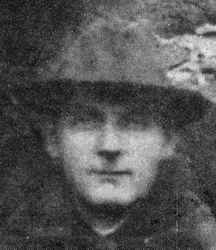
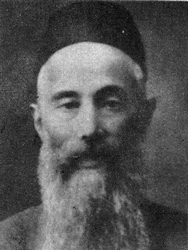
Etz Chaim Yeshiva - Braslav
Yavneh Zionist Religious School
Benevolence
Large sections of Jewish society of the Braslav region constituted of the destitute and poor. After the depression that followed WWI the benevolent 'Yakafa' society provided aid to tradesmen to reestablish their businesses. Aid was also given by the mutual fund - Gemilut Chesed that provided interest-free loans to the deprived to save them, quite literally, from starvation. Indeed, providing charity (tzdekah) was a central tenant of communal religious life. During crisis small philanthropic funds would spring up to provide a dowry or a feast for a wedding or to give foodstuffs for the poor at Pesach.
Raphael Yaacov Munitz
Yavneh School
Yitzhak Levi Weinstein
Sponsor of Folkshul
Milk Distribution for the Poor
Bikur Cholim Society
The Chuppah
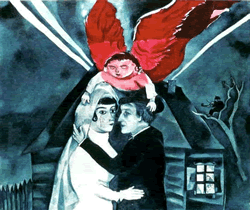
Culture
Located in the synagogue court was the fire-brigade, maintained mostly by Jewish volunteers. A central part of Braslav cultural life was the almost all-Jewish brass band. On holidays and festive occasions such as Constitution Day, the twenty-six musicians, dressed in their ceremonial uniforms, marched down 'die Grosse Gass' playing their shiny brass instruments led by the Polish bandleader Telraszewski.
The Yiddish theatre troupe, formed by people associated with the cultural stance of the Bund and the Folkshul, also used a hall in the fire-brigade building. The troupe staged plays - such as the Dybbukand Chasia the Orphan, vaudevilles and a variety of other performances. The whole courtyard would come alive during Purim. Scores of boys would throw firecrackers filled with gunpowder against the synagogue walls creating a deafening noise. After the establishment of a power station the town featured a cinema which screened silent films to the accompaniment of a violinist and a pianist, a post taken by Nuita Kantor-Zelikman in the thirties.
Gaiety and excitement reach fever pitch on the day of a wedding. The Chuppah was is set up on a flat, clean-swept spot. The shtetl turned out to a man and all gathered round the excited families of the young pair. All along the way where the bride and groom passed windows are lit up with candles. The groom, escorted by his close relatives was led to the canopy, accompanied by klezmer musicians playing the traditional 'nigun'.
Then the bride arrives with her mother and female relatives and walk around the groom seven times. The ceremony over, the groom breaks the glass underfoot - a reminder of the destruction of Jerusalem - and joyful cries of Mazel Tov erupt. The bride and groom walk hand in hand through the excited crowd, past the poor lined up on either side with buckets of water, into which the groom and guests drop coins. With lit candles in their hands, all escort the newly-weds to their wedding feast.
The Volunteer Fire Brigade Band
The Yiddish Theatre Troupe
Politics - Zionists, Bundists, Communists and Traditionalists
Zionism had first made its mark on Braslav with the establishment ofChovevei Zion in the town in the 19th century. The political activism of early twentieth century Eastern Europe formed the catalyst for various groupings of political parties and their associated youth movements to develop. Dominant amongst the Zionist parties wasHeChalutz, General Zionists, left and right factions of Poale Zion,HaShomer HaZair, and Mizrachi. Some later immigrated to Eretz Israel as chalutzim prior to the Shoah, including Moshe Valin, the Rabbi's son who joined Kibbutz Ramat Hakovesh and later founded the Li-La-Lo theatre in Tel Aviv, working as an impresario. Others were aficionados of the Revisionist movement, forming branches ofBetar and Brit Hachayal.
Socialist adherents of the Folkshul were influential among youth and Jewish worker circles and established a branch of the Bund. Beyond this there was also a small Communist party with a majority of Jewish members. Amongst then was Ephraim Amdor who after being jailed during the dictatorship of Pilsudski, was appointed mayor of Braslav after the Soviets took the town in 1939.
We should also remember that many Jews remained traditionally orthodox. From their ranks sprang an influential branch of the ultra-orthodox Agudat Israel.
Members of HeHalutz
HeHalutz Summercamp
Members of HeHalutz
Members of HeHalutz
With Yizhak Zukerman
Members of HeHalutz
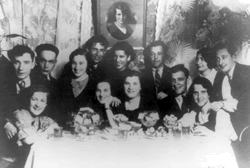
Betar Members
Moshe Valin
On Holiday and Partying
The End
The vibrant Jewish community of some 1500 souls that charged Braslav with economic, social and cultural life would come to a sudden end with the entry in June 1941 of the Nazi Germans to Braslav and the subsequent massacre of Braslav's Jews (and many others from the surrounding area) a year later. After the war a small community regrouped in Braslav, though most dispersed to other towns in the Soviet Union, Poland and to Israel. Those that stayed left a few simple burial markers on the site of the desecrated Jewish cemetery of a town that had been home to Jews for five centuries but is no longer.
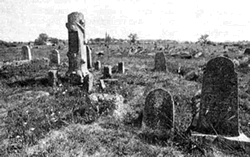
The Cemetery in Braslav Prior to its Desecration and Burial Markers of Braslav's Surviving Jews
For more information http://www.seligman.org.il/braslav_jews.html
